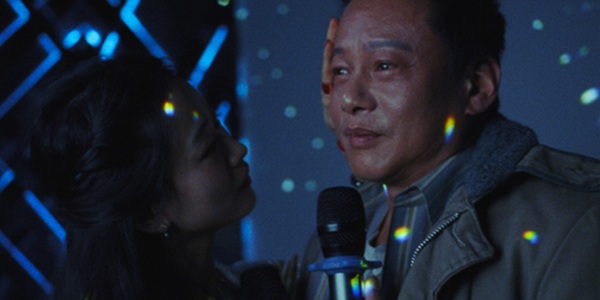
The debut feature from writer-director Constance Tsang, Blue Sun Palace pulls back the curtain of a Queens massage parlor to give us an intimate look at the lives of the immigrant women who work there. The undeniable toll that their work takes on them in body and spirit is tempered by the close friendships they have formed with each other, but a shocking act of violence plunges one of them into a pit of grief and loneliness that threatens to consume her entirely.
Blue Nights
Blue Sun Palace opens with a tender karaoke scene that introduces us to spirited Didi (Xu Haipeng) and her more subdued lover, Cheung (the always-excellent Lee Kang Sheng). Didi works in a massage parlor; Cheung works in construction and sends money home to his wife and daughter even as he seeks solace in the arms of other women on this side of the world. Didi tells Cheung of her dream to leave Queens and open a restaurant in beachside Baltimore with her coworker and close friend, Amy (Wu Ke-Xi); she gifts him the poster of the beach that she keeps on her bedroom wall so that he too can imagine the possibilities of a life elsewhere.
source: Dekanalog
Despite the difficult nature of their work—including disrespectful customers who underpay and insist on sexual favors despite them being against house rules—Didi, Amy, and their colleagues find comfort and happiness in exchanging gifts, sharing meals, and confiding in one another. They might be half a world away from their families, but together, they have created some kind of home. But a sudden, tragic event one Lunar New Year strikes at the heart of their sisterhood and sends Amy spiraling, eventually forcing her to confront what she really wants (and needs) to survive in this harsh and often unwelcoming world.
Amy and Cheung are brought together by their shared loss, yet as their relationship progresses, it becomes more and more obvious that they are not interested in being with each other so much as not being alone. What they have is not a real connection, but one of convenience; the moments they share and the memories they relive can provide a temporary source of comfort, but not one with enough substance to outlast their grief.
Mired in Melancholia
Blue Sun Palace is reminiscent of the cinema of Tsai Ming-Liang, and not just because his longtime muse, Lee Kang Sheng, is one of the stars. The film’s intense focus on the pain of alienation and loneliness—and the comfort that can be found in the most fleeting of interactions with someone who understands—echoes Tsai classics such as Vive L’Amour, Goodbye, Dragon Inn, and the more recent Days, while the languid pace and the almost uncomfortably long shots remind one of Tsai’s unflinching, steady gaze, which refuses to look away from what seems uneventful on the surface and instead probes deep into the heart of what makes such small, everyday occurrences so impactful.
source: Dekanalog
Blue Sun Palace is beautifully shot on film by Norm Li, though the loveliness of the cool, gauzy color palette, shot through with beams of warmth, feels a tad incongruous with the grittiness of the world these characters live in. The three performances at the center of the film are all compelling and poignant in different ways. Lee is incredibly moving as Cheung, yet another one of the unbearably lonely protagonists that he seems so uniquely capable of embodying on screen; his ongoing attempts to recreate key moments from his relationship with Didi with Amy before finally realizing that he cannot simply keep substituting one woman for another in his life are equal parts frustrating and heartbreaking to watch unfold.
As Didi, Xu brings an optimistic energy that is sorely missed once she exits the movie and the story descends into darkness; once she is gone, you find yourself desperately seeking any brief moment of levity to bring some light back into the story. Indeed, the almost unrelentingly depressing nature of the second half of Blue Sun Palace, in which the film teeters on the edge of succumbing to a few too many immigrant drama tropes (as true to life as those may be), is its biggest weakness. Fortunately, Wu’s remarkable performance ensures you stay invested in Amy and her struggles regardless. She makes Amy’s PTSD feel palpable even if you’ve been fortunate enough to never go through a similar experience.
Conclusion
Tsang is a confident and capable filmmaker to watch moving forward; Blue Sun Palace doesn’t feel like a debut feature, though it does certainly feel like a feature from someone who graduated from a prestigious film school. (In Tsang’s case, Columbia). Perhaps it wears its influences a little too prominently on its sleeve, but it is still a worthwhile film about the difficulties of immigrant life, including the relationships formed based solely on shared background, the struggle to succeed in a marginalizing culture, and the reluctance to admit defeat and return home to start over again.
Blue Sun Palace opens in New York and Los Angeles on April 25, 2025 before expanding to other markets.
Does content like this matter to you?
Become a Member and support film journalism. Unlock access to all of Film Inquiry`s great articles. Join a community of like-minded readers who are passionate about cinema – get access to our private members Network, give back to independent filmmakers, and more.







